Volume II By Benson J. Lossing 1851
Cherokee Ford. � Romantic Mountain Gorge. � Passage of King�s Creek. � A Night on the Mountains. � Contentment. � Mule Driving. � Yorkville. � Catawba Indians. � Fishing Creek and its Associations. � Generous Hospitality. � Petition of a Catawba Indian. � Great Falls of the Catawba. � Mount Dearborn. � Cotton Factory. � Rocky Mount and its Associations. � A Night at Rocky Mount. � The Battle-ground. � Sumter again in Arms. � His Compatriots. � Skirmish at Mobley�s Meeting-house. � Expeditions of Huck and Cunningham. � Their Defeat. � Sumter�s unsuccessful Battle at Rocky Mount. � His Success at Wateree Ford. � His Defeat at Fishing Creek. � Passage of the Catawba. � Appearance of the Road. � Anvil Rock. � Old Slave at Hanging Rock. � The Hanging Rock. � Disposition of Troops there. � Preliminary Skirmish. � Sumter�s Attack. � Sumter�s final Blow. � Victory lost by Intemperance. � Sumter�s Retreat. � The Loss. � Captain M�Clure. � The British in South Carolina. � Retreat of the Americans. � Massacre of Buford�s Regiment near the Waxhaw. � Family of President Jackson. � Journey toward Camden. � Flat Rock. � Rugeley�s Mill. � Tories at Rugeley�s. � Stratagem of Colonel Washington in capturing the Tories. � Gum Swamp. � Sander�s Creek. � Lincoln Calumniated. � De Kalb sent to the South. � His March. � Sketch of his Public Life. � Gates in chief Command. � De Kalb�s Monument and Inscription. � Tardiness of Justice. � Situation of Gates�s Army. � Plan of Operations. � Sketch of Gates�s Public Life. � Sufferings of the Army. � Alarm of the British. � Cornwallis at Camden. � Approach of Gates. � Gates�s Night-march toward Camden. � Cornwallis�s March to meet Gates. � General Gist. � Meeting of the Armies. � Skirmish. � Council of War. � Preparations for Battle. � The Attack. � Battle at Sander�s Creek. � General William Smallwood. � Death of the Baron de Kalb. � Flight of the Americans. � British Victorious. � The Armed Neutrality. � Confidence of the British. � Rendezvous at Hillsborough. � Governor Nash. � Colonel Buncombe. � Partial Organization of an Army. � Hobkirk�s Hill. � View at the Spring. � Gates�s Order. � Parole. � Greene�s Movements toward South Carolina. � His Encampment near Camden. � Lee�s Legion and Wolves. � Lord Rawdon at Camden. � Greene�s Camp on Hobkirk�s Hill. � Rawdon�s Preparations to Attack Greene. � Disposition of the Two Armies. � Battle on Hobkirk�s Hill. � Yielding of Maryland Troops. � Greene�s Retreat. � Washington�s Charge upon the Pursuers. � Marion and Lee against Watson. � British Evacuation of Camden. � Destruction of Property. � Fall of British Posts. � Sale of Traveling Establishment.
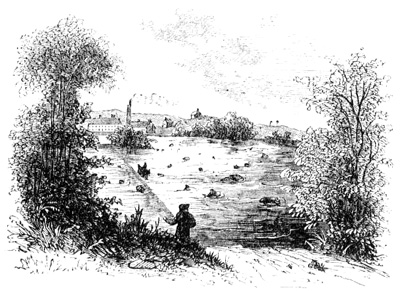 View At The Cherokee Ford[1] View At The Cherokee Ford[1]
At noon I crossed the Broad River at the Cherokee Ford, and turning to the southeast, pressed on toward Yorkville and the interesting fields of conflict beyond, near the waters of the Catawba and its surname, the Wateree, where the chivalrous partisans of the South, scorning the Delilah lap of ease, retained their strength and battled manfully with the Philistines of the crown. The river at the ford is about eight hundred yards wide, and upon the firm pathway, which has been constructed at considerable expense, the average depth of water did not exceed one foot. Unless the river is much swollen, the ford is perfectly safe. A strong dam, owned by the proprietors of the iron-works, crosses the river an eighth of a mile above; and so shallow and rapid is the current, and so rocky the bed of the river, for many miles in this vicinity, that it is quite unnavigable, except in a few places.
 Mountain Gorge Near the Cherokee Ford Mountain Gorge Near the Cherokee Ford
Soon after leaving the ford, I passed through a gorge of a spur of King�s Mountain, which here comes down in a precipitous ridge to the Broad River. The scenery within this gorge was the most romantic I had observed in the Southern country. From a ravine, just wide enough for the passage of a small stream and the high-way, the hills rise almost perpendicularly to a considerable altitude. They were covered with the various evergreens which give beauty to Southern forests in winter; and from the fissures of the rocks, where the water-fountains were bursting forth, hundreds of icicles were glittering in prismatic beauty wherever the sun shed its rays upon them. It was truly a gorgeous scene. Along this sinuous mountain stream, rock-bound on either side, the road continued to an iron establishment, where it ascends the steep margins of the hills, presenting a surface of deep adhesive red earth. Descending the eastern side of the eminence, I crossed King�s Creek, a dozen miles below the place where I passed it two days before when on my way to the Cowpens. Soon again I was among the rough hills, and so bad was the road, that at sunset I had traveled only ten miles from the Cherokee Ford. I discovered that the temporary repairs of my wagon had not been sufficient to withstand the rough usage of the way, and that more thorough work was necessary before I could pursue my journey with safety. Yorkville, the nearest place in advance where a smith could be found, was fourteen miles distant, so I was compelled to halt for the night at a small log-house, of forbidding aspect, among the mountains. The food and shelter was of the plainest kind imaginable. There was no "light in the dwelling," except the blaze of pine wood upon the hearth, and I wrote a letter by the glare of a resinous knot, brought from the "wood pile" for the purpose. Lying in bed, I could count the stars at the zenith while the open floor below afforded such ample ventilation, that my buffalo robe, wrapped around me, was not uncomfortable on that keen frosty night. But generous, open-handed hospitality was in that humble cabin, which made amends for trifling discomforts, and I felt satisfied.
Unwilling to risk a journey to Yorkville in my broken buggy, I hired a team of mules and a lumber-wagon from my host, to convey myself and baggage thither; and placing Charley and the vehicle in charge of his son, a lad of fourteen years, we started for the distant village at daybreak the next morning. All the way over that rough road I had practical evidence that mules are, like facts, "stubborn things." I was furnished with a hickory goad as long as an angler�s rod, and with this I labored faithfully, full half of the way, to whip the animals into a trot where a level space occurred. But I made no visible impression; walk they would, until they reached the brow of a hill, when they would descend with the vehemence of the swine of old, who, filled with devils, ran down into the sea. Down three long hills, rocky and gullied, they ran, while my energies were fully occupied in pulling at the reins with one hand, and securing my seat upon a loose board, covered with a sheepskin, with the other. I reached Yorkville in safety at a little past meridian, resolved never again to play postillion with mules or donkeys, whether biped or quadruped. Yorkville, the capital of York District, in South Carolina, almost two hundred miles from Charleston, is a very pleasant village of about eight hundred inhabitants, situated in the midst of a high plain, on the dividing-ridge between the waters of the Broad and Catawba Rivers. Sheltered from the northwest winds by the mountains, the climate is mild in winter; elevated far above the low country of the Carolinas, it is salubrious in summer. The streets of the village are regularly laid out, and adorned with beautiful Pride of India trees, filled, when I was there, with clusters of fruit. I saw some elegant mansions; and in the gardens, fine palmettoes, the first I had seen, were growing. I passed the Sabbath pleasantly in Yorkville, and left it early on Monday morning, with the impression that not a lovelier village flourishes in the "upper country" of the South. Leaving the great highway to Columbia on the right, I traversed the more private roads in the direction of the Catawba, to visit the scenes of valor and suffering in the vicinity of that stream. The weather was fine, and the roads generally good. Soon after leaving Yorkville, I passed through a part of the Catawba reservation, a narrow tract of land on the Catawba River, near the southeast corner of Yorkville District. The Catawba tribe, once so powerful, have dwindled down to the merest remnant. For their general adherence to the patriots during the Revolution, they have always received the fostering care of the state. Their number now does not exceed one hundred, and in a few years that once great rival tribe of the Five Nations will be extinct.[2] So the aborigines pass away, and the few survivors in our land may chant in sorrow,
I crossed the Fishing Creek at sunset; and at the house of a young planter, a mile beyond, passed the night. There I experienced hospitality in its fullest degree. The young husbandman had just begun business life for himself, and, with his wife and "wee bairn," occupied a modest house, with only one room. I was not aware of the extent of their accommodations when I asked for a night�s entertainment, and the request was promptly complied with. It made no difference to them, for they had two beds in the room, and needed but one for themselves; the other was at my service. The young man was very intelligent and inquiring, and midnight found us in pleasant conversation. He would accept no compensation in the morning; and I left his humble dwelling full of reverence for that generous and unsuspecting hospitality of Carolina, where the people will give a stranger lodgings even in their own bedrooms, rather than turn him from their doors.
[Jan. 15, 1849.] My journey of a day from Fishing Creek to Rocky Mount, on the Catawba, was delightful. The winter air was like a breath of late April in New England; and the roads, passing through a picturesque country, were generally good. Almost every plantation, too, is clustered with Revolutionary associations; for this region, like Westchester county, in New York, was the scene of continual partisan movements, skirmishes, and cruelties, during the last three years of the war. Near the mouth of the Fishing Creek (which empties into the Catawba two miles above the Great Falls), Sumter suffered defeat, after partial success at Rocky Mount below; and down through Chester, Fairfield, and Richland, too, Whigs and Tories battled fearfully for territorial possession, plunder, and personal revenge. Some of these scenes will be noticed presently. Turning to the left at Beckhamville[3], I traversed a rough and sinuous road down to the banks of the Catawba, just below the Great Falls. Here yet remain the foundations of a projected United States military establishment, to be called Mount Dearborn, which was abandoned; and upon the brink of the foaming waters stands a cotton-mill, the property of Daniel M�Cullock, operated by white hands, and devoted chiefly to the production of cotton-yarns. At this place, in the midst of a fine cotton-growing country, almost inexhaustible water-power invites capital and enterprise to seek good investment, and confer substantial benefit upon the state. The place is wild and romantic. Almost the whole volume of the river is here compressed by a rugged island into a narrow channel, between steep, rocky shores, fissured and fragmented, as if by some powerful convulsion. There are no perpendicular falls; but down a rocky bed the river tumbles in mingled rapids and cascades, roaring and foaming, and then subsides into comparative calmness in a basin below.
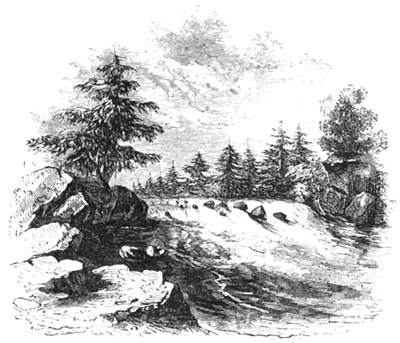 View Of The Great Falls Of The Catawba[4] View Of The Great Falls Of The Catawba[4]
It was late in the afternoon when I finished my sketch of the Falls, and leaving Mount Dearborn, crossed Rock Creek and reined up in front of the elegant mansion of Mrs. Barkley, at Rocky Mount. Her dwelling, where refined hospitality bore rule, is beautifully situated upon an eminence overlooking the Catawba and the surrounding country, and within a few rods of the remains of the old village and the battle-ground. Surrounded by gardens and ornamental trees, it must be a delightful summer residence. Yet there was grief in that dwelling and the habiliments of mourning indicated the ravages of death. The husband and father had been an honored member of the Legislature of South Carolina, and in the midst of his useful public life he was thrown from his gig and killed. Yet the light of hospitality was not extinguished there, and I shall long remember, with pleasure, the night I passed at Rocky Mount. Accompanied by Mrs. Barkley�s three daughters, and a young planter from "over the river," I visited the battleground before sunset, examined the particular localities indicated by the finger of tradition. and sketched the accompanying view of the principal place of conflict. Here, in the porch, sitting with this interesting household in the golden gleams of the declining sun, let us open the clasped volume of history, and read a brief but brilliant page.
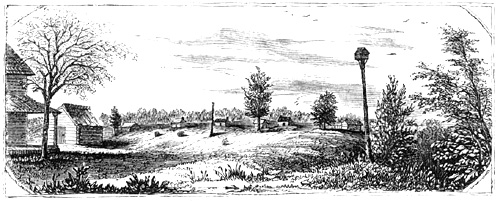 View At Rocky Mount[5] View At Rocky Mount[5]
[May 12, 1780] Almost simultaneously, three distinguished partisans of the South appeared conspicuous, after the fall of Charleston; Marion, between the Pedee and Santee; Sumter, upon the Catawba and Broad Rivers; and Pickens, in the vicinity of the Saluda and Savannah Rivers. With the surrender of Charleston, the hopes of the South Carolina patriots withered; and so complete was the subjugation of the state by the royal arms, that on the fourth of June, Sir Henry Clinton wrote to the ministry, "I may venture to assert that there are few men in South Carolina who are not either our prisoners or in arms with us." Many unsubdued patriots sought shelter in North Carolina, and others went up toward the mountains and gathered the cowed Whigs into bands to avenge the insults of their Tory oppressors. Early in July, Sumter (who had taken refuge in Mecklenburg), with a few chosen patriots who gathered around him, returned to South Carolina.
Already Whigs between the Catawba and Broad Rivers, led by Bratton, M�Clure, Moffit, Winn,[6] and others, had smitten the enemy at different points. The first blow, struck at Beckhamville, is noticed on the preceding page. To crush these patriots and to band the Loyalists, marauding parties, chiefly Tories, were sent out. At Mobley�s meeting-house, on the banks of Little River, in Fairfield District, a party of these men were collected just after the affair at Beckhamville.
About this time, Bill Cunningham and his "Bloody Scout" were spreading terror in Union and Spartanburg Districts, and also south of the Ennoree. Against this monster, John M�Clure was dispatched. He chased him across Union District, and almost thirty miles further toward Ninety-Six. Four of the scout were captured, and carried in triumph into Sumter�s camp, on the Waxhaw; their leader barely escaped. Sumter was now gathering his little army, and Huck proceeded to execute his commission as speedily as possible, before the newly-made brigadier should approach. He encamped upon the plantation of James Williamson [8] (now Brattonville), and there passed the night of the eleventh of July [1780]. At a little past midnight, Colonel Neil and the companies of Captains Bratton and M�Clure came down from Sumter�s camp, in Mecklenburg, and cautiously approached the sleeping enemy in his encampment, which was in the middle of a lane. At dawn [July 12.], they entered each end of the lane, and fell upon Huck�s party with fury. The surprise was complete, and for an hour a fierce battle ensued, when Huck, with Colonel Ferguson of the Tory militia, was killed, and his party dispersed. The whole patriot force was only one hundred and thirty-three men. M�Clure and his party, well mounted, pursued the fugitives almost to Rocky Mount, and within four hours the army of Huck was as completely dissolved as if they had never seen each other. Colonel Neil lost only one of his command. The defeat of Huck had an important bearing upon the future condition of the state. It encouraged the Whigs, and many joined the standard of Sumter; while the Tories, abashed, were fearful and silent. Strengthened by daily recruits, until he had more than six hundred men under his command, Sumter determined to attack the royal post at Rocky Mount. The massacre of Buford�s command on the Waxhaw, in May [May 29.], had fired the Whigs with a desire for revenge; and Sumter felt strong enough to attack a force known to be a third larger than his own. The post at Rocky Mount was now commanded by Lieutenant Colonel Turnbull, with a small garrison, consisting of one hundred and fifty New York volunteers, and some South Carolina militia. These were stationed principally in three buildings, upon a slope surrounded by a ditch and abatis, and encircled by an open wood. >On the thirtieth of July [1780.], Sumter left Major Davie�s camp, at the parting of the roads for Rocky Mount and Landsford, and crossing the Catawba at Blair�s Ford, proceeded cautiously, but swiftly, toward Rocky Mount. Davie, in the mean while, was to attack the outposts of the British camp at Hanging Rock, east of the Catawba, twelve miles distant. Sumter was accompanied by Colonels Neil, Irvine, and Lacy,[9] and Captain M�Clure and some of the Gastons. At an early hour of the day, he appeared with his whole force upon the crown of the hill now occupied by the servants� houses of Mrs. Barkley. The British commander, warned of his approach by a Tory, was prepared to receive him, and though the Americans poured severe volleys upon the fortification (if it might be called one), they produced but little effect. Having no artillery, they resorted to means for dislodging the enemy, seldom used in war. Leaping the abatis after three assaults, they drove the garrison into the houses. These, according to Mr. M�Elwees, who was in the engagement (mentioned on page 639), were situated near the bottom of the slope, and were composed of logs. They first attempted to set them on fire by casting burning fagots upon them. Not succeeding in this, an old wagon was procured, and upon it was placed a quantity of dry brush and straw taken from the abatis. These were ignited, and then rolled down against the houses. The British, perceiving their danger, hoisted a flag. Supposing they intended to surrender, Sumter ordered the firing to cease. At that moment a shower of rain extinguished the flames, and the enemy defied him. Having no other means at hand to dislodge or seriously injure the garrison. Sumter withdrew, first to the north side of Fishing Creek, near the Catawba (where he was surprised eighteen days afterward), and then to Landsford, where he crossed the river. Seven days [August, 1780.] afterward, he was battling with the enemy at Hanging Rock. Early in the action, in front of the abatis, the gallant Colonel Neil was slain, with two other white men and a Catawba Indian. Sumter had ten wounded, also. The British lost ten killed, and an equal number wounded. On the seventh of August Sumter attacked a British post on Hanging Creek, an event which we shall consider presently. Immediately after that engagement, he recrossed the Catawba. In the mean while, General Gates, with his army, had arrived in the neighborhood. Advised by Sumter that a British detachment, with stores for the main army at Camden, was on its way from Ninety-Six, Gates ordered that officer to intercept it [Aug. 15.], and detached to his aid one hundred infantry and a company of artillery of the Maryland line, and three hundred North Carolina militia, all under the command of Lieutenant-colonel Woodford, of Virginia. They captured a redoubt at the Wateree Ford, in Fairfield District, and, intercepting the escort from Ninety-Six, they secured forty-four wagon loads of stores and clothing, with a number of prisoners. On the seventeenth, Sumter was unformed of the defeat of Gates, near Camden. Continuing up the Catawba (here called Wateree), he managed to elude the pursuit of Colonel Turnbull, whom Cornwallis had sent after him, and, on the eighteenth, encamped at the Fishing Creek, near the Catawba, a little above the Great Falls. Here he determined to allow his wearied troops to repose. But a more vigilant and active foe than Turnbull was upon his trail. Cornwallis, anxious to capture Sumter, dispatched Tarleton to overtake and smite him. With one hundred dragoons and sixty mounted light infantry, that officer pressed forward, without halting, in pursuit of his prey. Crossing the Catawba at Rocky Ford, he got into the rear of Sumter, and fell upon his camp while resting, the patriot leader having had no intimation of his approach. The Americans were routed, with great slaughter. More than fifty were killed, and three hundred were made prisoners. All the stores, clothing, and prisoners, captured by Sumter on the fifteenth, fell into Tarleton�s hands. This blow laid South Carolina in submission at the feet of the royal troops, none but Marion, the wily " Swamp Fox," and a few followers, remaining in arms against the king. The subsequent organization of a force under Sumter, his exploits west of the Broad River, and also the important events which followed the assumption, by Greene, of the command of the Southern army, have been detailed in former chapters.
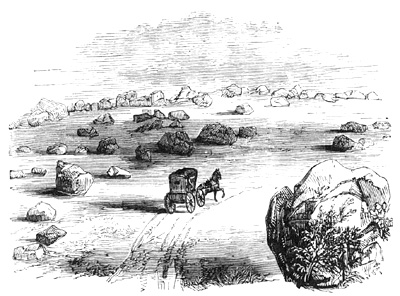 Appearance Of The Road Appearance Of The Road
I left the family of Mrs. Barkley with real regret, on the morning after my arrival, and, pursuing a crooked, steep, and rough road down to the brink of the river, crossed the Catawba upon a bateau, at Rocky Mount Ferry, just below the Falls at the mouth of Rocky Mount Creek. The scenery here, and for some miles on my road toward Hanging Rock, my next point of destination, was highly picturesque. I was approaching the verge of the Lowlands, the apparent shore of the ancient ocean, along which are strewn huge bowlders � chiefly conglomerates � the mighty pebbles cast upon the beach, when, perhaps, the mammoth and the mastadon slaked their thirst in the waters of the Catawba and the Eswawpuddenah. For several miles the road passed among the erratic rocks and curiously-shaped conglomerates.
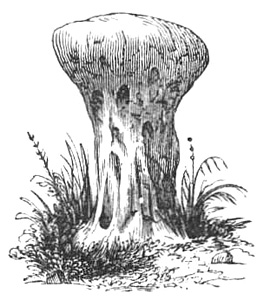 Anvil Rock Anvil Rock
When within three miles of Hanging Rock, I passed the celebrated Anvil Rock, one of the remarkable curiosities of the South. It stands alone, on the north side of the road, and is, indeed, a curiosity. It appears to be a concretion of the soil around, being composed of precisely similar material; or the soil may be disintegrated rocks of a similar character. In its sides are cavities from which large pebbles have apparently fallen, and also furrows as if made by rains. Its height above the ground is about twelve feet; its form suggested its name. I reached the Lancaster and Camden high-way at noon, and, on inquiry, ascertained that the celebrated Hanging Rock, near which Sumter and his companions fought a desperate battle, was about a mile and a half eastward. Thither I went immediately, notwithstanding the temptation of a good dinner, freely offered, was before me, for I desired to get as far on toward Camden, that night, as possible. The roads were now generally sandy, and in many places soft and difficult to travel, making progress slow. Along a by-road, across the high rolling plain upon which (at Coles�s Old Field) tradition avers the hottest of the battle was fought, I rode to the brow of a deep narrow valley, through which courses Hanging Rock Creek, one of the head waters of Lynch�s Creek, the western branch of the Great Pedee. The mingled sound of falling waters and grinding mill-stones came up from the deep furrow, while from a small cabin by the road side, upon the verge of the steep bank, I heard a broken melody. Alighting, I entered the cabin, and there sat an aged negro dining upon hoe-cake and bacon, and humming a refrain. He was the miller. His hair was as white with the frost of years, as his coarse garb was with flour. To my question respecting his family, he said, shaking his bowed head, "Ah, massa! I lives all alone now; tree years ago dey sole my wife, and she�s gone to Mississippi. Hab to bake my own hoe-cake now. But neber mind; needn�t work �less I�m a mind too; �nough to eat, and pretty soon I die?" He told me that he was more than eighty years old, and remembered seeing "de red coats scamper when Massa Sumter and Jacky M�Clure pitched into �em." Pointing to the celebrated Hanging Rock upon the opposite side of the stream, "Dar," he said, "a heap o� red coats sleep de night afore de battle, and dar I hid de night arter." From the venerable slave, whose memory appeared unclouded, I learned the location of several points mentioned in the accounts of the engagement.
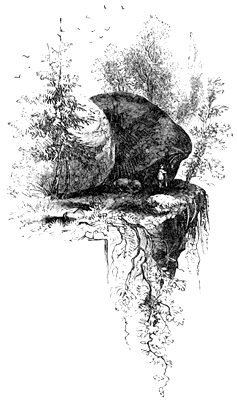 Hanging Rock Hanging Rock
Leaving Charley to dine upon the verge of the stream, I proceeded to Hanging Rock, of whose immensity I had heard frequent mention. It is a huge conglomerate bowlder, twenty or thirty feet in diameter, lying upon the verge of the high east bank of the creek, nearly a hundred feet above the stream. Around it are several smaller bowlders of the same materials. It is shelving toward the bank, its concavity being in the form of the quarter of an orange paring, and capacious enough to shelter fifty men from rain. Beneath its canopy, let us turn to the record of history. Near the Hanging Rock, on the western bank of the creek, Lord Rawdon, the British commander in that section, had established a post, which was garrisoned by the infantry of Tarleton�s legion, part of Brown�s corps of South Carolina and Georgia Provincials, and Colonel Bryan�s North Carolina Loyalists; the whole were under the command of Major Camden, with the Prince of Wales�s American regiment, in number about five hundred. The greater portion were Loyalists, the remainder were regulars. In the formation of the camp, the regulars were on the right; a part of the British legion and Hamilton�s regiment in the center; and Bryan�s corps and other Loyalists some distance on the left, Hanging Rock Creek being in the rear. As we have seen (page 660), Major Davie proceeded to an attack upon this post, simultaneously with Sumter�s assault on Rocky Mount. Davie, with his cavalry, and some Mecklenburg militia, under Colonel Higgins, marched toward Hanging Rock. As he approached, he was informed that three companies of Bryan�s Loyalists, returning from a foraging excursion, were encamped at a farm-house. He fell upon them with vigor, in front and rear, and all but a few of them were either killed or wounded. The spoils of this victory were sixty horses with their trappings, and one hundred muskets and rifles. This disaster made the garrison exceedingly vigilant. We have observed that after the assault on Rocky Mount, Sumter crossed the Catawba, and proceeded toward Hanging Rock [Aug. 6, 1780]. He marched early in the morning cautiously, and approached the British camp in three divisions, with the intention of falling upon the main body, stationed upon the plain at Coles�s Old Field. The right was composed of Davie�s corps and some volunteers, under Major Bryan; the center, of Colonel Irwin�s Mecklenburg militia; and the left, of South Carolina regulars, under Colonel Hill. Through the error of his guides, Sumter came first upon Bryan�s corps, on the verge of the western bank of the creek, near the Great Rock, half a mile from the British camp. Irwin made the first attack. The Tories soon yielded and fled toward the main body, many of them throwing away their arms without discharging them. These the Americans seized; and, pursuing this advantage, Sumter next fell upon Brown�s corps, which, being on the alert, poured a heavy fire upon him from a wood. They also received him with the bayonet. A fierce conflict ensued, and for a while the issue was doubtful. The riflemen, with sure aim, soon cut off almost all of Brown�s officers and many of his soldiers; and at length his corps yielded and dispersed in confusion. The arms and ammunition procured from the vanquished were of great service, for when the action commenced, Sumter�s men had not two rounds each. [10] Now was the moment to strike for decisive victory; it was lost by the criminal indulgence of Sumter�s men in plundering the portion of the British camp already secured, and drinking freely of the liquor found there. A similar cause plucked the palm of victory from the hands of Greene at Eutaw Springs. Sumter�s ranks became disordered; and while endeavoring to bring order out of confusion, the enemy rallied. Of his six hundred men, only about two hundred, with Davie�s cavalry, could be brought to bear upon the remaining portion of the British, who were yet in some confusion, but defended by two cannons. Sumter was not to be foiled. With a shout, he and his handful of brave men rushed forward to the attack. The enemy had formed a hollow square, with the field-pieces in front, and in this position received the charge. The Americans attacked them on three sides, and the contest was severe for a while. At length, just as the British line was yielding, a re-enforcement, under Captains Stewart and M�Donald, of Tarleton�s legion, returning from an excursion toward Rocky Mount, appeared, and their number being magnified, Sumter deemed a retreat a prudent measure. This was done at meridian, but the enemy had been so severely handled, that they did not attempt a pursuit. A small party appeared upon the Camden road, but was soon dispersed by Davie. Could Sumter have brought all of his forces into action in this last attack, the rout of the British would have been complete.
With his few prisoners and booty, Sumter retreated toward the Waxhaw, bearing away many of his wounded. The engagement lasted about four hours, and was one of the best-fought battles, between militia and British regulars, during the war. Sumter�s loss was twelve killed and forty-one wounded. Among the former were the brave Captain M�Clure[11], of South Carolina, and Captain Read, of North Carolina; Colonel Hill, Captain Craighead, Major Winn, Lieutenants Crawford and Fletcher, and Ensign M�Clure, were wounded. The British loss exceeded that of the Americans. Captain M�Cullock, commander of the legion infantry, and two officers and twenty privates of the same corps, were killed, and forty were wounded[12]. Brown�s regiment also suffered much. Bryan�s Tories did not stop to fight,
About nine miles north of the present Lancaster Court House, and between twenty and twenty-three miles above Hanging Rock, upon the Waxhaw Creek[13], the regiment of Colonel Abraham Buford was massacred by Tarleton on the twenty-ninth of May, 1780. Sir Henry Clinton took possession of Charleston on the twelfth, and immediately commenced measures for securing the homage of the whole state. He sent out three large detachments of his army. The first and largest, under Cornwallis, was ordered toward the frontiers of North Carolina; the second, under Lieutenant-colonel Cruger, was directed to pass the Saluda, to Ninety-Six; and the third, under Lieutenant-colonel Brown, was ordered up the Savannah, to Augusta. Soon after he had passed the Santee, Cornwallis was informed that parties of Americans who had come into South Carolina, and had hurried toward Charleston to assist Lincoln, were as hastily retreating. Among these was Colonel Buford. His force consisted of nearly four hundred Continental infantry, a small detachment of Washington�s cavalry, and two field-pieces. He had evacuated Camden, and, in fancied security, was retreating leisurely toward Charlotte, in North Carolina. Cornwallis resolved to strike Buford, if possible, and, for that purpose, he dispatched Tarleton, with seven hundred men, consisting of his cavalry and mounted infantry. That officer marched one hundred and five miles in fifty-four hours, and came up with Buford upon the Waxhaw. Impatient of delay, he had left his mounted infantry behind, and with only his cavalry, he almost surrounded Buford before that officer was aware of danger. Tarleton demanded an immediate surrender upon the terms granted to the Americans at Charleston. Those terms were humiliating, and Buford refused compliance.[14] While the flags for conference were passing and repassing, Tarleton, contrary to military rules, was making preparations for an assault, and the instant he received Buford�s reply, his cavalry made a furious charge upon the American ranks. Having received no orders to defend themselves, and supposing the negotiations were yet pending, the Continentals were utterly dismayed by this charge. All was confusion, and while some fired upon their assailants, others threw down their arms and begged for quarter. None was given and men without arms were hewn in pieces by Tarleton�s cavalry. One hundred and thirteen were slain; one hundred and fifty were so maimed as to be unable to travel; and fifty-three were made prisoners, to grace the triumphal entry of the conqueror into Camden. Only five of the British were killed, and fifteen wounded. The whole of Buford�s artillery, ammunition, and baggage, fell into the hands of the enemy. For this savage feat, Cornwallis eulogized Tarleton, and commended him to the ministry as worthy of special favor. It was nothing less than a cold-blooded massacre; and Tarleton�s quarter became proverbial as a synonym to cruelty.[15] The liberal press, and all right-minded men in England, cried shame.
After the battle, a large number of the wounded were taken to the log meeting-house of the Waxhaw Presbyterian congregation, where they were tenderly nursed by a few who had the boldness to remain, With the defeat of Buford, every semblance of a Continental army in South Carolina was effaced. This terrible blow spread consternation over that region, and women and children were seen flying from their homes to seek refuge from British cruelty in more distant settlements. Among the fugitives was the widowed mother of Andrew Jackson (the seventh President of the United States), who, with her two sons, Robert and Andrew, took refuge in the Sugar Creek congregation, at the house of the widow of the Reverend J. M. Wilson, near Charlotte. This was the first practical lesson of hatred to tyranny which young Jackson learned, and it doubtless had an abiding influence upon his future life.[16] Returning to the Lancaster road at two o�clock, I rode on toward Camden, about thirty-five miles distant, passing on the way the celebrated Flat Rock, a mass of concrete, like that of Anvil Rock, five hundred yards across. It lies even with the surface of the ground, and presents numerous pits or cisterns, supposed to have been hollowed out by the Indians for the purpose of holding water. The road passed over this mass with a gentle descent. Near its southern side, the place was pointed out to me where a severe skirmish occurred in August, 1788[sic], between some militia and Tories, but the result was not very sanguinary. At sunset I arrived at the house of Mrs. Fletcher, within nine miles of Rugeley�s Mill, where I was well entertained for the night.[17] I departed at sunrise the following morning. Being now fairly within the sandy region upon the slopes between the upper and the lower country, the traveling was very heavy. At the first house after leaving Mrs. Fletcher�s, I saw Mr. Paine, the brother of Mrs. Lee, an intelligent old man of eighty-four years. During half an hour�s conversation with him, I obtained some valuable information respecting the various historical localities between there and Camden. The first of these is Clermont, sometimes called Rugeley�s, about thirteen miles north of Camden, where I arrived at an early hour in the forenoon. This is the place where General Gates concentrated his army for an attack upon the British at Camden. The place is also memorable on account of a military event which occurred near Rugeley�s Mill, on the fourth of December, 1780. This mill was about one hundred yards east of the road where it crosses Rugeley�s Creek.
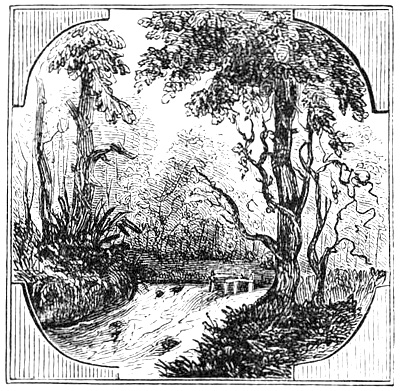 View At The Site Of Rugeley�s Mill View At The Site Of Rugeley�s Mill
No traces of the mill remain; but an embankment, several rods in extent, partly demolished, and overgrown with pines and shrubbery interlaced with the vines of the muscadine, mark the place of the dam, a part of which, where the creek passes through, is seen in the engraving. Let us consider the event which immortalizes this spot. When Cornwallis retreated from Charlotte (see page 626), Gates advanced to that place, and General Smallwood was directed to encamp lower down the Catawba, on the road to Camden. Morgan, with his light corps, composed partly of Lieutenant-colonel Washington�s cavalry, was ordered to push further in advance, for the purpose of foraging, and to watch the movements of Cornwallis. Smallwood having received information that a body of Tories under Colonel Rugeley, were on the alert to intercept his wagons, ordered Morgan and Washington to march against them. They retreated, and took post at Rugeley�s house, on the Camden road, which he had stockaded, together with his log-barn. Washington, with his cavalry, pursued, and at about ten o�clock on the fourth of December [1780], appeared at Rugeley�s Mill, on the south side of the creek.
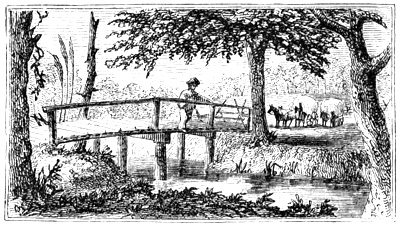 View at Rugeley's[18] View at Rugeley's[18]
The Loyalists were strongly posted in the log-barn, in front of which was a ditch and abatis. Having no artillery, Washington could make but little impression upon the garrison, so he resorted to stratagem. Fashioning a pine-log so as to resemble a cannon, he placed it in such a position near the bridge as, apparently, to command both the house and barn of Colonel Rugeley. He then made a formal demand for a surrender, menacing the garrison with the instant demolition of their fortress. Alarmed at the apparition of a cannon, Rugeley sent out a flag, and, with his whole force of one hundred and twelve men, immediately surrendered. Poor Rugeley never appeared in arms afterward. Cornwallis, in a letter to Tarleton [Dec. 4], said, "Rugeley will not be made a brigadier."[19]
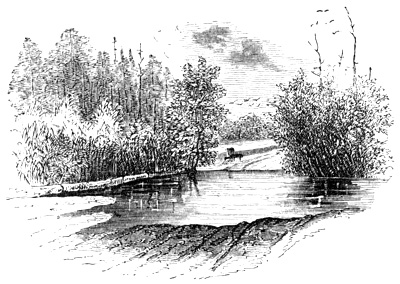 View at Gum Swamp[20] View at Gum Swamp[20]
Soon after leaving Rugeley�s, I came to a shallow stream which flows out of Gum Swamp, and known in the Revolution as Graney�s Quarter Creek. It was thickly studded with gum shrubs and canes, the latter appearing as green and fresh as in summer. It was now about noon, and while I made the accompanying sketch, Charley dined upon corn, which the generous driver of a team "hauling cotton," gave me from his store. Between this stream and Sander�s Creek, within seven miles of Camden, is the place of Gates�s defeat [Aug. 16, 1780.]. The hottest of the engagement occurred upon the hill, just before descending to Sander�s Creek from the north, now, as then, covered with an open forest of pine-trees. When I passed through it, the undergrowth had just been burned, and the blackened trunks of the venerable pines, standing like the columns of a vast temple, gave the whole scene a dreary, yet grand appearance. Many of the old trees yet bear marks of the battle, the scars of the bullets being made very distinct by large protuberances. I was informed that many musket-balls have been cut out of the trees; and I saw quite a number of trunks which had been recently hewn with axes for the purpose. Some pines had been thus cut by searchers for bullets which must have been in the seed when the battle occurred. Within half a mile of Sander�s Creek, on the north side, are some old fields, dotted with shrub pines, where the hottest of the battle was fought. A large concavity near the road, filled with hawthorns, was pointed out to me as the spot where many of the dead were buried.
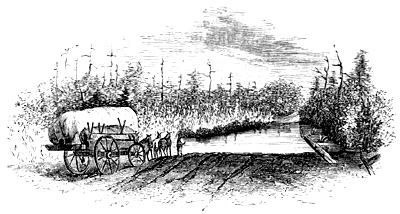 View at Sanders Creek[21] View at Sanders Creek[21]
Sander�s Creek is a considerable stream, about two hundred feet wide, and quite shallow at the ford. Though flowing through a swamp like Graney�s Quarter, its waters were very limpid. Numerous teams drawing heavy loads of cotton, on their way to Camden, were passing at the time, and the songs and loud laughter of the happy teamsters enlivened the dreary aspect of nature. [22 Let us consider the important events which occurred here. Misfortune is too often mistaken for a fault, and censoriousness seldom makes candid distinctions. When General Lincoln was finally obliged to surrender Charleston and his army to Sir Henry Clinton [May 1, 1780]>, calumny, with its busy tongue, decried his fair fame, and whispered doubts respecting his skill and courage. That blow, struck by a skillful hand, almost demolished the Southern army, and for a moment the patriots were dismayed. But the elasticity of hope was found in the national councils, and preparations were soon made to concentrate the various detachments of the regular army then in the South, and the volunteers whom Sumter and others were collecting, to turn back toward the sea-board the flood of invasion.
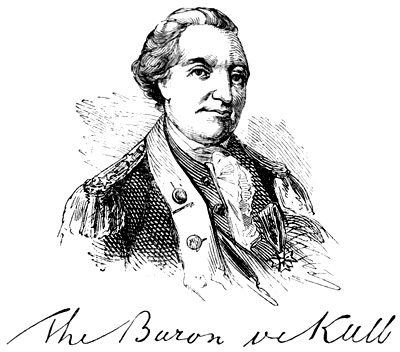
A month before the fall of Charleston, when it was perceived that the chief theater of the campaign of 1780 was to be in the Southern States, Maryland and Delaware troops were sent thither, under the Baron De Kalb,[23] a German officer, who had distinguished himself in the French service. He left Morristown [April 14, 1780] with fourteen hundred effective men; reached the head of Elk in May; left Petersburg early in June, passed through Hillsborough, and halted on Deep River, in North Carolina, on the sixth of July. In the mean while, Charleston had been captured, General Lincoln was a prisoner on parole, and De Kalb became the commander-in-chief at the South. Although Congress reposed confidence in the skill of De Kalb, it was thought proper to send an officer better known to the people for past services, and on the thirteenth of June [1780], General Gates was appointed to the command.[25] He was then at his estate in Virginia, a few miles from Shepherdstown, and the glory of Saratoga was not yet dimmed.
 [Signature of William Clajon] [Signature of William Clajon]
He immediately departed [June 26] for the camp of De Kalb, taking with him, as secretary, his friend William Clajon, and reached his destination on the twenty-fifth of July. The prospect before him was far from flattering. An army without strength; a military chest without money; but little public spirit in the Commissary Department; a climate unfavorable to health; the spirits of the Republicans pressed down; Loyalists swarming in every direction, and a victorious enemy pressing to spread his legions over the territory he had come to defend, were obstacles in the way of success. Yet he did not despond, and, retaining De Kalb in command of his division, prepared to march into South Carolina. His whole force consisted of the Maryland and Delaware troops, a legionary corps of sixty horse and as many foot soldiers, under Colonel Armand, and three companies of artillery. There was elsewhere a considerable force of North Carolina militia in the field, under General Caswell; and on the morning of the twenty-seventh [July, 1780], Gates marched at the head of his little army to effect a junction with those troops.
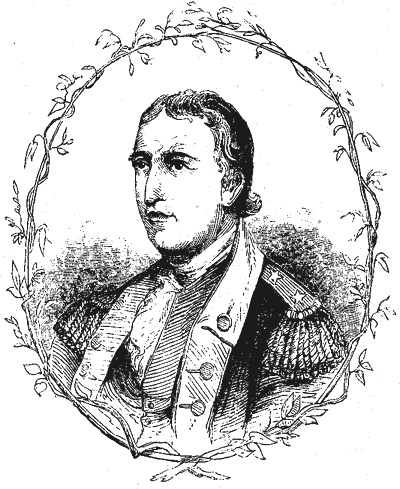 General Horatio Gates[24] General Horatio Gates[24]
He passed the Deep River at the Buffalo Ford, and in the afternoon encamped upon Spinks�s farm, on the road to Camden. There the plan of immediate operations was decided upon. De Kalb and Colonel Otho H. Williams (the deputy adjutant general) thought it expedient to march to Charlotte, establish a hospital and magazine at Salisbury, leave the women and all the heavy baggage there, and from thence proceed toward Camden, without impediment, through a well-cultivated and friendly country, by the way of the Waxhaw. These opinions had no weight with Gates, whose vanity overruled his judgment, and on the twenty-eighth, having been joined that morning by Lieutenant-colonel Porterfield with about one hundred Virginians, he marched directly for Camden. The country through which the Americans passed was sparsely populated, and in many places exhibited nothing but swamps and pine barrens. The heat was intense. Sickness and want of provisions soon began the work of death. Lean cattle found in the woods, green corn, and peaches, constituted the principal portion of their food. Dysentery ensued, and at one time the total destruction of the army seemed inevitable. Yet Gates pressed slowly forward, and on the day when Sumter achieved his partial victory at Hanging Rock, he reached the banks of Little Lynch�s Creek, a few miles distant, where he was joined by General Caswell.[26] Let us glance a moment at the movements of the British troops We have noted how the grand army was divided and spread over South Carolina (see page 664) soon after the fall of Charleston, the northern portion of which was placed under the command of Cornwallis. This disposition of the forces of the enemy had hardly taken place, when intelligence of the approach of De Kalb was received; also of the gathering of Virginians under Porterfield; of North Carolinians, under Rutherford, in the west; and of a large body of North Carolina militia, under Caswell, in the east. Then came the intelligence that Gates, the conqueror of Burgoyne, was on his way, with a large force, to recover all that Lincoln had lost, and more, if possible. Rumor magnified their numbers. The Loyalists became alarmed; the patriots took courage; and, as we have seen, Marion and Sumter had raised their standards. The British officers were perplexed; and Lord Rawdon, who was second in command to Cornwallis, and had his post at Camden, called in some of his more distant outposts. Major M�Arthur, who was at Cheraw to encourage the Loyalists, was ordered to fall back toward Camden; and the most distant outposts were upon Lynch�s Creek, at Hanging Rock, and at Rocky Mount. These, as we have seen (page 662), were attacked by Sumter, Davie, and other active officers, with their men. Cornwallis, perceiving the gathering storm on the borders of South Carolina, hastened from Charleston to join Rawdon at Camden. He arrived there on the thirteenth of August, and learned, with much concern, the successes of Sumter, and the disaffection of the people, especially in the county between the Black River and the Pedee. Nearly eight hundred of his troops were sick at Camden, and his effective force amounted to only a little more than two thousand men, fifteen hundred of whom were regulars. The remainder were militia and North Carolina refugees. Cornwallis would gladly have retreated to Charleston, but the consideration that he must leave his sick behind, abandon or destroy his magazines, and relinquish all the territory they had gained, except Charleston, prevented that step. He therefore resolved to move forward and attack Gates before the Virginia troops, known to be approaching, could join him. On the day when Cornwallis reached Camden, Gates advanced to Clermont, and encamped near Rugeley�s Mill. Those who had opposed Sumter at Hanging Rock had fled to Camden on the approach of Gates, and Lord Rawdon had also called in the garrison which he had stationed at Rugeley�s. The day after his arrival there [August 14, 1780], Gates was joined by General Stevens, with seven hundred militia; and, at about noon, a message from Sumter announced the approach of stores and clothing on the west side of the Wateree, for the enemy at Camden. The capture of these stores, and the dispersion of the escort, we have considered on page 660. Notwithstanding Gates had weakened his army by sending a strong re-enforcement to Sumter, he prepared to march upon Camden, to divert attention from Sumter�s enterprise, and to fight, if necessary. On the evening of the fifteenth, he sent his sick, extra stores, and heavy baggage, under guard, to the Waxhaw, and at ten o�clock at night commenced his march. Colonel Armand�s legion composed the van, flanked upon the right by Porterfield�s infantry, in Indian file, two hundred yards from the road; and upon the left by Armstrong�s infantry, in the same order.
 Next followed the first and second Maryland brigades, under Brigadiers Smallwood and Gist, [27] and the Delaware troops, all commanded by De Kalb: then the North Carolina division, under Caswell; the Virginia division, under Stevens; with a rear-guard of volunteer cavalry upon the flanks of the baggage. Confident in his strength by such a disposition of his troops, he ordered Colonel Armand to withstand the attack of the enemy�s cavalry, whatever its number. The most profound silence was commanded, and instant death was threatened to the soldier who should fire a gun until ordered.[28] Cornwallis, notwithstanding his inferior force, marched to attack Gates at Rugeley�s, being informed that his position was a weak one. At the same hour when Gates marched toward Camden, Cornwallis struck his tents at that place, and proceeded cautiously toward Rugeley�s. His troops consisted of the 23d and 33d regiments, under Lieutenant-colonel Webster (who was afterward mortally wounded at Guilford); Tarleton�s legion; Irish Volunteers; a part of Lieutenant-colonel Hamilton�s North Carolina regiment; and Bryan�s corps of Loyalists, under Lord Rawdon, with two six and two three pounders commanded by Lieutenant M�Leod; and the 71st regiment. Camden was left in the care of Major M�Arthur, with the sick and convalescents. Silently both armies marched in the gloom of night. The air was sultry; no moon was in the heavens, but the stars looked down in serene radiance upon the earth. Not a footfall was heard in the deep sand, and neither party was aware that the other had struck his tents, until the advanced guards of each met at about two o�clock in the morning [August 16.], upon the gentle slope about half a mile north of Sander�s Creek. Both parties were surprised, and each fired almost at the same moment. Some of Armand�s troops were killed at the first fire, and so sudden and unexpected was the attack that the remainder fell back in disorder upon the first Maryland brigade. That column was broken by the shock, and the whole line was filled with consternation. Porterfield, with his usual gallantry, rushed forward and attacked the left of the enemy�s van, while Armstrong, with equal gallantry and decision, attacked them on the right, and they were brought to a pause. Porterfield was severely wounded, carried to the rear of the army, and died a few days afterward. Both armies halted, and some prisoners having been taken by both parties, the position of the respective forces became known to each other. The situation of the British was far more advantageous than that of the Americans. They had crossed Sander�s Creek, and they were completely guarded in the rear by an impenetrable swamp. The Americans were upon rising ground in an open wood, and were obliged to be watchful of their flanks. When the first excitement of the encounter had subsided, Gates called a council of officers. A retreat was practicable, and would doubtless have been prudent. No one seemed willing to propose it; and when, to Gates�s remark, "Gentlemen, you know our situation, what are your opinions?" General Stevens replied, "It is now too late to retreat;" the silence that ensued was interpreted as favorable to an attack, and the commander-in-chief remarked, "Then we must fight; gentlemen, please take your posts."
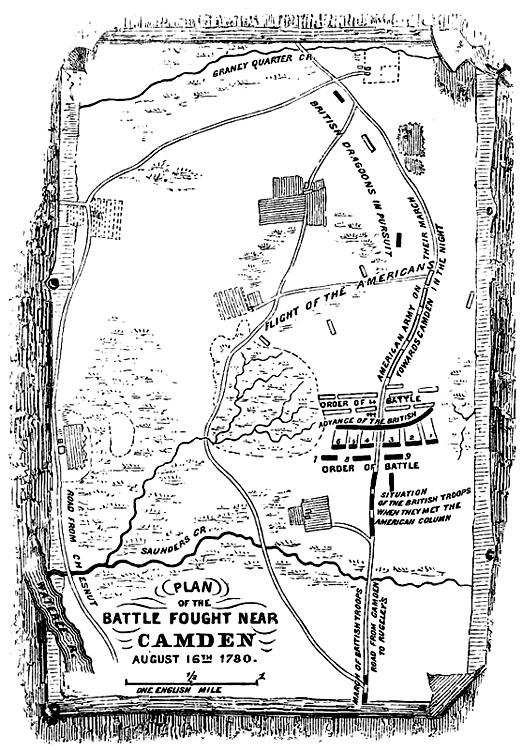 The British army formed in line for battle, the right under the command of Webster, and the left under Rawdon, and anxiously awaited the dawn. The Americans, also, soon recovered from the panic produced by the attack, and formed in battle order. The second Maryland brigade, and the Delaware troops, under General Gist, took the right; the North Carolina militia, under Caswell, the center; and the Virginians, under Stevens, the left. The first Maryland brigade, under Smallwood, was formed in reserve. De Kalb, charged with the line of battle, took post on the right. The artillery of both armies was planted directly in front of the center. All these preparations were made in darkness, and the belligerents were ignorant of each others� movements. In the plan here given, copied from Stedman, the black parallelograms denote the British troops, and the open ones the Americans.
The first beam of morning was the signal for attack. While the British were maneuvering to gain a better position, the American artillery opened its volleys upon them. At the same moment, Colonel Williams, with a band of volunteers, pressed forward upon the enemy�s right, followed by Stevens, with his Virginians, who were urged to rely upon the bayonets with which they had been furnished the day before. Webster immediately brought the British right to bear upon Williams and Stevens, with such force, as to break the Virginia column and scatter it to the winds. They delivered only a single fire, and then, panic-stricken, threw away their arms, and fled in great confusion. The North Carolina militia (except Dixon�s regiment, which was next to the Continentals) followed the shameful example, and the exertions of Stevens, Caswell, and even of Gates himself, to stop or rally the fugitives, were unavailing. Only the Continental troops, with Dixon�s regiment, were now left to oppose the enemy. Upon the Maryland and Delaware troops fell the weight of battle, and for a while they nobly sustained it. On the right, De Kalb and Gist maintained their ground, though sorely pressed by Rawdon and his regulars. Lieutenant-colonel Howard (the subsequent "hero of the Cowpens"), with Williams�s regiment, charged the enemy with great vigor, and disconcerted them. Inch by inch the Marylanders gained ground, and, had the militia stood firm, and kept Webster employed, the British must have been routed and driven in confusion across Sander�s Creek. That skillful officer had detached Tarleton in pursuit of the fugitives, and when Smallwood[29] came forward with his reserve to fill the place of the scattered militia, Webster brought his regiments to bear upon him. Finally, the battle raged along the whole line, and victory was uncertain. Firm as a rock the phalanx of De Kalb and Gist remained. At length, perceiving an advantage, De Kalb ordered a bayonet charge. The slaughter was great; the enemy recoiled, and fifty men became the prisoners of the Americans.
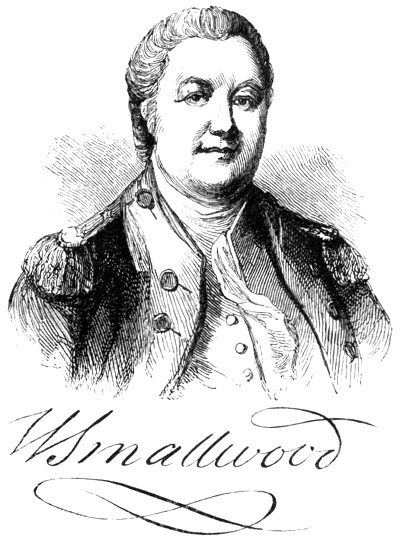 Smallwood, in the mean time, sustained himself gallantly; but at length Webster gained his flank, and his brigade receded. It soon regained its position; was again driven back, and speedily it rallied to the combat. Cornwallis perceived the point of strength to be with De Kalb and Gist, and, concentrating his whole force, he made a terrible charge there. It was the decisive stroke which smote down the American strength and won the victory. Another charge was made; the brave Marylanders gave way, and, with the Delaware regiment, broken and maimed, fled to the swamps. They were hotly pursued, and many were killed in the flight. The militia fell in great numbers under the sabers of Tarleton�s cavalry, and for more than two miles the open wood was strewn with the dead and dying. Arms, artillery, horses, and baggage were scattered in every direction. More than a third of the Continental troops were killed; and of the wounded, one hundred and seventy men were made prisoners. The Delaware regiment was nearly annihilated, and Colonel Vaughn and Major Patten being taken prisoners, the remnant, less than two companies, were placed under the command of the brave Kirkwood, the senior captain, who had been with Washington at Trenton and Princeton. De Kalb, while trying to keep his troops firm when the last charge was made, fell, pierced with eleven wounds. His lieutenant, Du Buysson, threw his arms around him, gave his name and rank, and while saving him from instant death, was terribly wounded himself by British bayonets. In the mean while Gates had fled, "borne off the field by a current of dismayed militia," who "constituted so great a part of his army, that when he saw them break and flee, he lost all hope of victory." [30] With Caswell, he hastened to Clermont, hoping to check and rally the militia at their old encampment, near Rugeley�s Mill. This hope was vain, for the further the dismayed troops fled, the more they became dispersed, and the generals giving up all as lost, proceeded, with a few attendants, to Charlotte, where they arrived in the evening of the same day, though about eighty miles distant. On his way, Gates heard of the success of Sumter at the Wateree Ford, but that triumph came too late to afford him aid, and, as we have seen (page 660)>, two days afterward [Aug. 18, 1780.], Sumter and his band were surprised and dispersed at Fishing Creek. General Rutherford surrendered to a party of the British legion. The other generals escaped, but were separated from their respective commands. The rout was complete, and only Major Andrus, of the third Maryland regiment, succeeded in rallying any part of the fugitives. Most of the Virginia militia retired to Hillsborough by the road they came to camp, and there General Stevens gathered many of them together. Their time of service soon expiring, they were discharged. [31]
The victory of Cornwallis was complete, and for a moment the hopes of the patriots, particularly at the South, were crushed; their only chance of success seemed to be the intervention of European nations. [32] Within the space of three months, two armies had been almost annihilated by capture and dispersion, and the most active partisan corps scattered to the winds. [33] Cornwallis considered the subjugation of South Carolina accomplished, and, confident of future success, moved toward the North State to establish royal rule there. His march to, and retreat from Charlotte; the defeat of his detachments at King�s Mountain and the Cowpens; the pursuit of Greenebattle at Guilford; the retreat of the British to Wilmington; their march into Virginia; and the final capture of Cornwallis�s army at Yorktown, have been considered in preceding chapters. General Gates was much censured on account of the defeat of the Americans on Sander�s Creek, because he provided for no place of rendezvous in the event of being obliged to retreat; for not having his baggage and stores at a proper distance from the scene of action, and because of an improper arrangement of his army for attack, placing his unskilled militia on the right, opposite the British veterans of Webster. Armand spoke harshly of Gates, and even intimated that he was a coward or a traitor. Gates�s great fault appears to have been a too sanguine belief that he could easily crush the inferior force of his enemy. His vanity was always the source of his greatest trouble. In this instance he was too confident of success, and made no provision for the contingencies of adversity; and hence his utter weakness when the victorious blow was struck by the British, and he was obliged to flee. On the seventeenth and eighteenth [August, 1780], Smallwood and Gist arrived at Charlotte, with several other officers, and there they found more than one hundred regular infantry, Armand�s cavalry, Major Davie�s partisan corps from the Waxhaw settlement, and a few militia. Gates began to hope that another army might be speedily reorganized, when intelligence of the disaster of Sumter at Fishing Creek reached him. He retreated to Hillsborough, where the Provincial Congress was in session, with Governor Abner Nash [34] at its head. That officer exerted all the power and influence of his station to aid the discomfited general. The Legislature provided for procuring arms, ammunition, and stores; ordered militia drafts, and took other vigorous measures for the defense of the state. Salisbury, toward which it was believed Cornwallis would march, was made the place of rendezvous. The fragments of the army broken at Sander�s Creek were collected together at Hillsborough early in September, and on the sixteenth of that month, Colonel Buford, having recruited his corps so cruelly handled by Tarleton, reached head-quarters, from Virginia. There he was joined by sixty Virginia militia, and about fifty of Porter-field�s light infantry. All of these, with the Maryland and Delaware regiments, were formed into a brigade, under Smallwood. The intervening events, from this time until Greene succeeded Gates in the command of the Southern army [Dec. 3., 1780], have already been considered.[35]
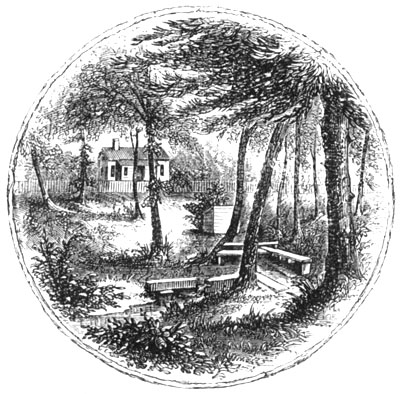 View at the Spring; Hobkirk's Hill[36] View at the Spring; Hobkirk's Hill[36]An hour�s ride from Sander�s Creek, over a very sandy and gently rolling country, brought me to the summit of Hobkirk�s Hill, a high ridge overlooking the plains of Camden. Upon the table-land of its summit is a beautiful village, composed of many fine houses, the residences of wealthy inhabitants of that region, who have chosen this spot for its salubrity in summer. It was just at sunset when I first looked from this eminence upon the town below and the broad plain around it. Although it was midwinter, the profusion of evergreens gave the landscape the appearance of early autumn. Here was fought one of the memorable battles of our War for Independence; and yonder, stretching away toward the high hills of Santee, is the plain once red with British legions, and glittering with British bayonets. Before descending to Camden, a mile distant, let us open the old chronicle, and peruse an interesting page. It is a balmy evening [Jan. 17, 1849.]; birds are chirping their vespers among the dark-green foliage of the wild olives in the gardens, and buds are almost bursting into blossoms upon every tree. Here, upon a bench by the bubbling spring, where General Greene was at breakfast when surprised by Lord Rawdon, we will read and ponder in the evening twilight. We left General Greene and his broken army on their march from Cornwallis�s camp, on the Deep River [April 6, 1781.], toward Camden. (See page 613.) Greene had determined to strike a blow for the recovery of South Carolina. To secure the provisions which grow upon the borders of the Santee and Congaree Rivers, and to keep a communication with the Indians on the frontier, the British had established military posts at several points, the most important of which was Fort Watson, upon Wright�s Bluff, in the present Sumter District. These, with the more remote post of Ninety-Six, Greene resolved to attack almost simultaneously with his movement against Lord Rawdon, then at Camden. He dispatched Lieutenant-colonel Lee with his legion, to join Marion, then encamped in the swamps on Black River, in Williamsburg District. [37] These brave partisans met on the fourteenth [April, 1781.], and immediately prepared to march against Fort Watson. Brigadiers Sumter and Pickens were informed of the intended movements, and refused to co-operate. Greene desired Sumter to join him at Camden, while Pickens was directed to assemble the western militia and invest Ninety-Six, or, at least, to prevent a re-enforcement marching from that post to the relief of Rawdon. With only about fifteen hundred men (after detaching Lee�s force), Greene descended the Southern slope of Hobkirk�s Hill [April 19.], and encamped at Log Town, within half a mile of the enemy�s works, at Camden.
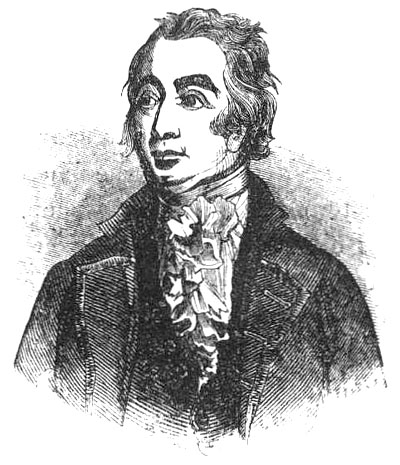 Lord Rawdon, From an English Print.[38] Lord Rawdon, From an English Print.[38]Lord Rawdon, who had been left in command of the Southern division of the royal army when Cornwallis marched into North Carolina, was now at Camden. He was apprised of Greene�s approach, and notwithstanding his force was inferior (about nine hundred men), he was too strongly intrenched to fear an attack. Greene perceived that his little army was unequal to the task of carrying the place by storm, or even of completely investing it. [39] Hoping to be joined by a re-enforcement of militia, he withdrew to Hobkirk�s Hill, and encamped. On the twenty-first, he received the startling information that Colonel Watson, with between four and five hundred men, was marching up the Santee to join Rawdon. To prevent this junction, it was necessary to intercept Watson some distance from Camden. To this task Greene immediately applied himself. He crossed Sand Hill Creek, and encamped on the east of Camden [April 22.], upon the Charleston road. It being impossible to transport the artillery across the marshes on the borders of that creek, Lieutenant-colonel Carrington was directed to return with it toward Lynch�s Creek, where it would be safe from the patrolling parties of the enemy. Finally, convinced that the intelligence of the approach of Watson was false, [40] Greene hastened back to Hobkirk�s Hill, and ordered Carrington to join him, with the artillery, immediately [April 24.]. The hill was then completely covered with a forest, and the Americans were so strongly posted, with the swamp on Pine Tree Creek in their rear, that they felt no fear of an attack from the enemy. Yet the ever-cautious Greene had the army encamped in battle order, ready to repel a sortie of Rawdon, should he have the temerity to attempt one. During the day, he had received information of the capture of Fort Watson by Marion and Lee, and just at evening the prisoners were brought into camp, among whom were several American soldiers, previously captured, and who, as they said, had enlisted in the British service as the best means of escaping to their friends.
During the night of the twenty-fourth, a drummer, named Jones, one of the Americans taken at Fort Watson, deserted, and made his way to the British camp. He informed Rawdon of the detachment of the artillery from the main army, the lack of provisions in the American camp, and the fact that Sumter had not arrived. Rawdon resolved to strike a blow at this favorable moment, for his own provisions were almost exhausted; and before daylight his garrison was in marching order. The country between Hobkirk�s Hill and Camden was so thickly wooded that the movements of the enemy were not discerned until his van-guard approached the American pickets. The patriots were unsuspicious of danger. Greene and his officers were leisurely taking breakfast under the shade of the trees at the spring, pictured on page 676 (for it was a clear, warm morning); some of the soldiers were washing their clothes, and the horses of Washington�s cavalry were unsaddled. Rawdon did not march directly for the American camp, on the Waxhaw road, but took a circuitous route, toward the Pine Tree Creek. At about ten o�clock, the American advanced guard discerned the approach of the enemy. Their pickets were commanded by Captain Benson, of Maryland, and Captain Morgan, of Virginia, supported by Captain Kirkwood, [41] with the remains of the Delaware regiment. These, at a distance of about a quarter of a mile from the camp, gallantly received and returned the fire of the British van, and kept them at bay while Greene formed his army in more complete battle order.
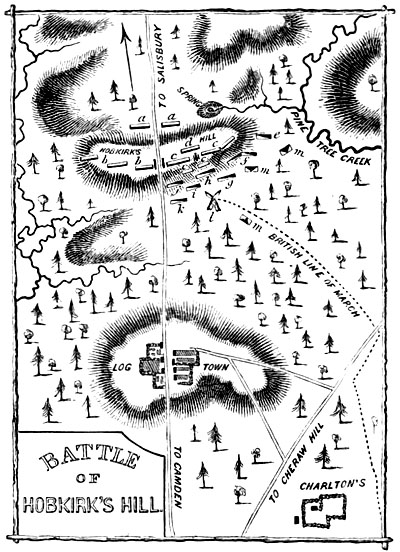
Fortunately for Greene, Carrington, with the artillery, had joined him early in the morning, and brought to camp a competent supply of provisions. The line was soon formed, and so confident was Greene of success, that he unhesitatingly ordered Lieutenant-colonel Washington, with his cavalry, to turn the right flank of the British, and to charge in their rear. The American line was composed of the Virginia brigade on the right, under Brigadier Huger, with Lieutenant-colonels Campbell and Hawes; the Maryland brigade, led by Colonel Williams, seconded by Colonel Gunby, and Lieutenant-colonels Ford and Howard, occupied the left; and in the center was Colonel Harrison, with the artillery. The reserve consisted of Washington�s cavalry, and a corps of two hundred and fifty North Carolina militia, under Colonel Reade. (See the map.) The skirmish of the van-guards was severe for some time, when Rawdon, with his whole force, pressed forward, and drove Kirkwood and his Delawares back upon the main line. The King�s American regiment was on his right; the New York Volunteers in the centre; and the 63d regiment composed the left. His right was supported by Robertson�s corps, and his left by the Irish Volunteers. (See map.) The British presented a narrow front, which was an advantage to Greene. As they moved slowly up the slope, Campbell and Ford were ordered to turn the flanks of the British, while the first Maryland regiment, under Gunby, was ordered to make an attack in front. Rawdon perceived this movement, and, ordering the Irish corps into line, strengthened his position by extending his front. The battle opened from right to left with great vigor. The two Virginia regiments, led by Greene in person, aided by Huger, Campbell, and Hawes, maintained their ground firmly, and even gained upon the enemy. At the same time, Washington, with his cavalry, was sweeping every thing before him upon the right flank of the British. The artillery was playing upon the center with great execution, and Gunby�s veteran regiment rushed forward in a deadly charge with bayonets. Notwithstanding their inferiority of numbers and disadvantage of position, the British maintained their ground most gallantly until Gunby�s charge, when they faltered. Hawes was then descending the hill to charge the New York Volunteers, and the falchion that should strike the decisive blow of victory for the Americans was uplifted. At that moment, some of Gunby�s veterans gave way: their commander was killed. Colonel Williams, who was near the center, endeavored to rally them, and Gunby and other officers used every exertion to close their line. In this attempt, Colonel Ford was mortally wounded and carried to the rear. Gunby, finding it impossible to bring them into order, directed them to rally by retiring partially in the rear. This order was fatal. Perceiving this retrograde movement, the British advanced with a shout, when a general retreat of the Americans took place. Greene, with his usual skill and energy, conducted the retreat in such order that few men were lost after this first action. Washington had been eminently successful; and at the moment when the retreat began, he had two hundred prisoners. He hastily paroled the officers, and then, wheeling, made a secure retreat, with the loss of three men, and took with him fifty of his prisoners. The action continued at intervals until about four o�clock in the afternoon, when the Americans had retreated four or five miles, closely pursued by parties of the enemy. Washington, with cavalry and infantry, then turned upon the pursuers, and charging the mounted New York Volunteers with great intrepidity, killed nine and dispersed the rest. This terminated the battle. The British returned to their works at Camden, and Greene, with his little army, encamped for the night on the north side of Sander�s Creek. The dead, alone, occupied the battle-field. So well was the retreat conducted, that most of the American wounded (including six commissioned officers), and all of their artillery and baggage, with Washington�s fifty prisoners, were carried off. The loss of the Americans in killed, wounded, and missing, according to Greene�s return to the Board of War, was two hundred and sixty-six; that of the enemy, according to Rawdon�s statement, two hundred and fifty-eight. The killed were not very numerous. Greene estimates his number at eighteen, among whom were Ford and Beatty, <[42] of the Maryland line. [43] Rawdon�s loss in killed was thirty-eight, including one officer. [44]
This defeat was very unexpected to General Greene, and for a moment disconcerted him, for, with the exception of the success of Marion and Lee, in capturing Fort Watson, he did not know how the Southern partisans were proceeding. [45] The Maryland troops, so gallant and firm on all former occasions, had now failed; his provisions were short; Sumter, the speedy partisan, had not joined him; and supplies came in tardily and meager. Yet Greene was not the man to be crushed by adversity. On the contrary, he seemed to rise with renewed strength, after every fall. Accordingly, on the morning succeeding the battle [April 26, 1781.], he retired as far as Rugeley�s, and after detaching a small force with a six pounder under Captain Finley, to Nelson�s Ferry, to join Marion and Lee, and prevent Watson from re-enforcing Rawdon, he crossed the Wateree, and took a strong position, where he could not only cut off supplies for the garrison at Camden from that quarter, but prevent the approach of Watson in that direction. In the mean while, Marion and Lee were closely watching Colonel Watson. That officer had now approached near to the confluence of the Congaree and Wateree, in Orangeburg District; where he would cross it was difficult to tell and the vigilant partisans, fearing he might elude them if they took post on the north side of the Congaree, crossed over, and endeavored to overtake him. But Watson, who was equally vigilant and active, crossed the Congaree [May 6, 1781.], near its junction with the Wateree, and on the seventh of May passed the latter stream and joined Rawdon at Camden. Greene was early apprised of this junction, and, persuaded that Rawdon would resume offensive operations at once, withdrew from the vicinity of Camden Ferry to the high ground beyond Sawney Creek, on the border of Fairfield District. He was not mistaken. On the eighth [May.], Rawdon crossed the Wateree, at the ferry below Camden, [46] and proceeded toward Greene�s encampment. The two armies were now equal in numbers; about twelve hundred each. On the approach of the British, Greene retired to Colonel�s Creek; at the same time, Rawdon became alarmed at the intelligence of the increase of the American army and of Greene�s strong position, and returned to Camden. Believing it impossible to drive Greene from his neighborhood, and anxious for the safety of his menaced posts between him and Charleston, Rawdon resolved to evacuate Camden, and with it all the country north of the Congaree. He sent orders to Lieutenant-colonel Cruger to abandon Ninety-Six, and join Lieutenant-colonel Brown at Augusta, and also directed Major Maxwell to leave Fort Granby (near the present city of Columbia), and fall back upon Orangeburg, on the bank of the North Edisto. He then burned the jail, mills, and several private houses at Camden; destroyed all the stores which he could not carry with him, and on the tenth left that place for Nelson�s Ferry, hoping to cross there in time to drive off Marion and Lee, then besieging Fort Motte. He took with him almost five hundred negroes and the most violent Loyalists, fearing the vengeance of the patriots, followed him in great numbers. [47] Within six days afterward, Orangeburg [May 11.], Fort Motte [May 12.], the post at Nelson�s Ferry [May 14.], and Fort Granby [May 15.], fell into the hands of the Americans. Greene, in the mean while, had marched toward Ninety-Six, where he arrived on the twenty-second of May. The military events at these several places will be noticed presently, in the order in which I visited them. It was almost dark when I rode into Camden and alighted at Boyd�s Hotel. Here was the end of my tedious but interesting journey of almost fourteen hundred miles with my own conveyance; for, learning that I could reach other chief points of interest at the South easier and speedier by public conveyance, I resolved to sell my traveling establishment. Accordingly, after passing the forenoon of the next day [Jan. 18, 1849.] in visiting the battle-ground on Hobkirk�s Hill, sketching the scenery at the Spring, and the monument erected to the memory of De Kalb, on the green in front of the Presbyterian church in Camden, [48] I went into the market as a trafficker. A stranger both to the people and to the business, I was not successful. I confess there was a wide difference between my "asking" and my "taking" price. My wagon was again broken, and, anxious to get home, I did not "dicker" long when I got an offer, and Charley and I parted, I presume, with mutual regrets. He was a docile, faithful animal, and I had become much attached to him. A roll of Camden bank-notes soothed my feelings, and I left the place of separation at dawn the next morning in the cars for Fort Motte and Columbia, quite light-hearted.
Footnotes in original
|

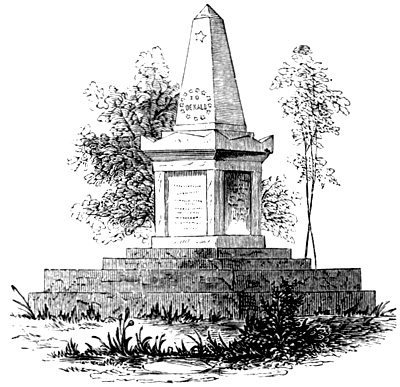 De Kalb�s Monument
De Kalb�s Monument

 Nash's Monument
Nash's Monument [Edward Buncombe's signature]
[Edward Buncombe's signature]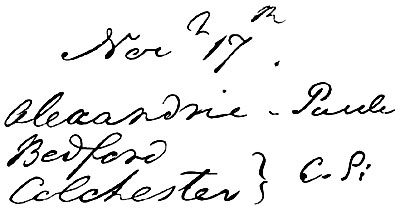 Form of Parole and Countersign
Form of Parole and Countersign